Movable machine gun nest / wedge "Object 217"
The development of the “Object 217” project started at the very beginning of 1940 of the year on the order of the Red Army command. At this time, the Soviet Union fought with Finland, and the army had to face a number of characteristic problems. In particular, he constantly let himself be aware of the lack of armored vehicles capable of supporting troops in the offensive. The military wanted in the shortest possible time to get a light and cheap sample of armored vehicles capable of supporting infantry with machine-gun fire and protecting their own crew from enemy bullets. The execution of such an order was entrusted to the Special Design Office No. XXUMX of the Leningrad Kirov Plant under the direction of J. Ya. Kotin.
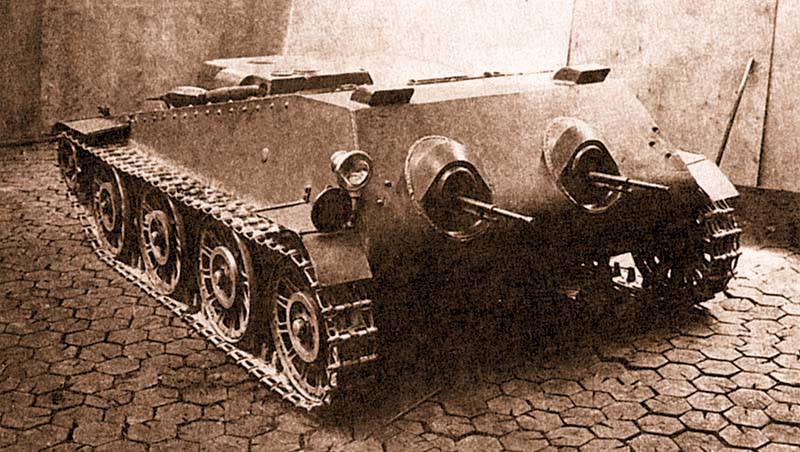
The only known shot of the PPG-1 prototype. Photos Otvaga2004.ru
Having received the technical task, employees of SKB-2 set to work. L.E. was appointed the lead designer of the new project. Sychev. The new wedge received the working designation “217 Object”. Later, during the military tests, a promising model of armored vehicles was called PPG-1 - "Movable machine-gun nest, the first model." Both names are equivalent, and can also be used without any confusion with other models of armored vehicles.
The main requirements for the new project stipulated the use of machine-gun weapons, relatively powerful protection and permeability in complex landscapes. In addition, the developers of the “217 Object” decided to increase the survivability of the machine by reducing its dimensions. Among other things, such features of the project should have led to a decrease in mass with improved mobility. The result of the preliminary work was the formation of the original appearance of the promising light class armored vehicles.
In order to maximize the size of the machine, I had to use the original layout of the internal volumes of the case. In addition, the designers were forced to abandon some of the units that improve performance, but complicate and weight the design of the machine. In particular, it was planned to simplify the composition of the transmission and chassis. Also significantly reduced the volume of the fighting compartment.
Within the framework of the “Object 217” project, an original armored hull was created, able to protect the crew from rifle weapons and artillery shell fragments. The front part of such a body was to be made of 20-mm armor plate. The hull sides were 10 mm thick. All other parts were 8 mm thick. To further increase the level of protection, rational angles of armor were used.
The front part of the body was made of a curved sheet. Its upper and lower parts remained straight, but there was a significant bend in the center. Behind the top of the forehead was a small horizontal section of the roof. Behind it was placed a large sheet of the roof, placed at an angle. In the stern of the roof, an additional raised casing was provided. Behind the machine was protected by a curved forage sheet of small thickness. The bottom is made horizontal, the sides are vertical.
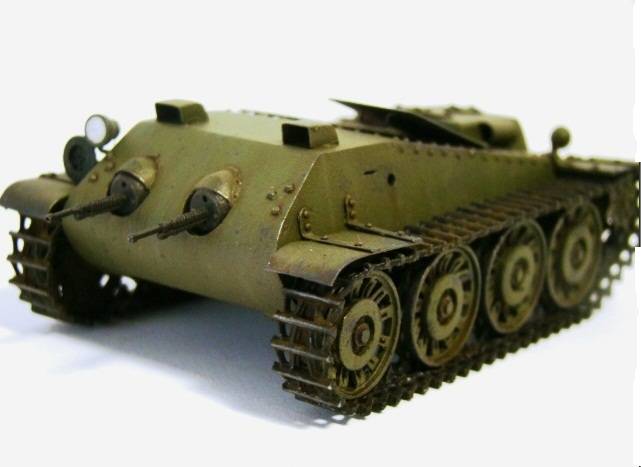
Modern layout of the “217 Object”, front side view. Photo Bronetechnikamira.ru
The front part of the body was given a manned volume, performing the functions of a fighting compartment and a control compartment. A small compartment of the stern of the hull had to accommodate the engine and transmission. The internal volume of the case was quite small. Thus, the maximum height of the habitable volume did not exceed 55, see. The aft part of this compartment was even smaller, which could impede the work of the crew.
In the stern of the hull, it was proposed to install a two-stroke two-cylinder motorcycle engine of a horizontally opposed layout PMZ with a power 16 hp The lower part of the engine was placed inside the armored car body, and for the top, protruding above the roof, it was necessary to create a special casing with beveled sides, having several hatches for access inside. The exhaust pipe with a silencer was placed to the right of the casing on the roof of the case. Next to the engine placed three-speed manual gearbox with three speeds forward and one reverse. With the gearbox mating friction clutches that perform the functions of the rotation mechanism. It was proposed to drive the car using a set of levers connected to transmission units.
The “217 Object” got an extremely simple undercarriage. On each board it was proposed to install four large-diameter skating rinks. To facilitate the construction, the rollers had a spit-like structure. Any elastic elements in the suspension were not provided for: the axes of the rollers were rigidly fixed on the sides of the machine. At the same time, the project implied the use of internal depreciation of the rollers. Front support rollers served as guide wheels. In the rear part of the hull there were two driving wheels of small diameter, they were approximately half the size of the rollers. The large diameter of the rollers allowed to do without additional rollers. The upper branch of the caterpillar was supposed to lie directly on them.
On the sides of the hull were installed small wings covering the front and rear of the tracks. Full futuristic shelves were not envisaged by the project.
In accordance with the task of the customer, the new armored vehicle was supposed to carry machine-gun armament. Designers SKB-2 LKZ proposed to equip the "217 Object" with two machine guns such as DT. In large openings of the frontal body part, it was proposed to mount two ball mounts. The design of machine gun installations allowed shelling a section of the front hemisphere several tens of degrees wide. It was also possible to change the stem elevation within a certain vertical sector. It is noteworthy that the angles of targeting machine guns, primarily limited to the small volume and specific ergonomics of the habitable compartment, but not the design of machine-gun installations.
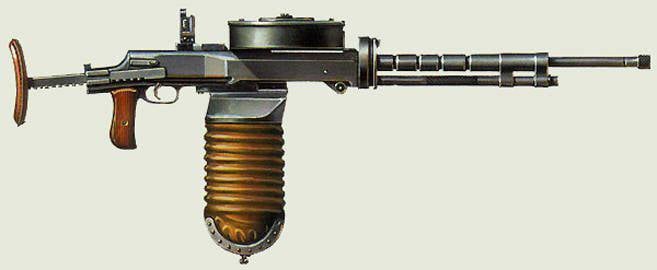
DT machine gun with a regular store and bag-bag. Figure Opoccuu.com
The armament of the "Object 217" was two "7,62-mm tank machine gun of the Degtyarev system mod. 1929 " Machine guns of this type used a rifle cartridge 7,62x54 mm R and were equipped with disk magazines with a capacity of 63 rounds. Automation based on the removal of powder gases gave a rate of fire of 600 rounds per minute. With an initial bullet velocity of about 840 m / s, the machine gun had an effective firing range of up to 800 m. The design of the DT machine gun, based on the infantry DP, had a number of features necessary for mounting on machine gun mounts of armored vehicles.
Ammunition of two machine guns consisted of 1575 cartridges. They were placed in 25 disk stores. Ammunition was proposed to be transported on special mounts of the sides of the fighting compartment. This arrangement of ammunition to some extent made it difficult to replace stores, but allowed to bring the transported ammunition to acceptable values.
The crew of the "Mobile machine-gun nest" was to consist of two people. One of them acted as a mechanic-driver, and in a combat situation both crew members were responsible for the use of weapons. An interesting feature of the project was the change in the position of the crew in preparation for the battle. When moving to the battlefield, the crew had to be placed in a sitting position in the aft part of the habitable compartment, for which a large double hatch in the roof had to be opened. Before the battle began, the driver and the gunner had to lie on the bottom of the hull and close the hatch behind him, after which they could use weapons and not fear return fire.
A large doorway in the sloping part of the roof, closed by two doors of the hatch, was used for landing in the car. Such covers could fold back and forth. In the combat position, the hatch closed, providing protection for the crew against attacks from above. The main means of monitoring the situation in the battle position were two periscopic devices in front of the roof. With their help, it was possible to search for targets for machine guns, and aiming was carried out with the help of standard sights. The heads of the periscope instruments were protected by box-shaped housings, which gave the frontal part of the body a characteristic appearance.
On the case there were two sets of lighting equipment. On the front of the starboard placed a pair of headlights. Another similar product was to be in the stern, on the left side.
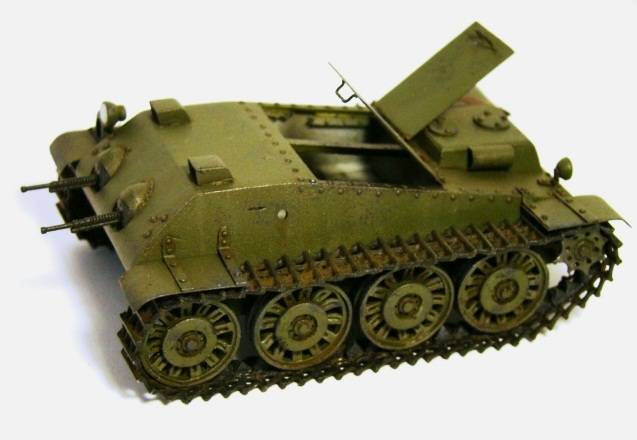
Layout PPG-1, the upper hatch is open. Photo Bronetechnikamira.ru
One of the main tasks of the project was to reduce the dimensions of the combat vehicle. Due to the use of the original layout of internal volumes and some other ideas, this problem was successfully solved. The length of the "Object 217" tanket was only 2,5 m, width - 1,72 m, height - 0,86 m. Ground clearance was equal to 300 mm and could not change due to the stiff suspension. The combat weight of the armored vehicle was only 1,73 tons.
The 16-strong motorcycle engine provided a specific power of about 9,5 hp, which did not allow us to expect high mobility, but it was considered sufficient to solve the problems posed. The maximum speed of the car on a good road was to reach 18,5 km / h. The fuel range is up to 100 km. There was the possibility of climbing a slope with a steep 35 ° or 40-cm wall. Width of the moat to be overcome is 1 m. Without preparation, water barriers could be crossed along fords up to 0,5 depth. Sealing the hull yielded 40% buoyancy margin.
However, the wedge had some limitations in terms of mobility. Due to the use of a stiffer suspension, the armored car did not differ much in comfort, which should have led to the crew’s rapid fatigue. For this reason, it was proposed to transport the equipment over long distances by half-ton trucks. With its own move, PPG-1 was only supposed to go into battle and move through the battlefields.
The development of the 217 Object project took only a few weeks. Already in March, 1940, the Leningrad Kirov Plant built the first prototype of an armored vehicle. In accordance with the order of the army, four more prototypes should be built in the near future. Five "mobile machine-gun nests" were supposed to be used in factory, state and military tests. According to the results of all inspections, it was planned to draw conclusions and resolve the issue of adopting new equipment for service.
The first conclusions about the project PPG-1 / "Object 217" were made during the factory tests. Checks showed that SKB-2 engineers managed to create an original military vehicle, but the prospects for this development were in doubt. It was found that the new tankette has a number of characteristic flaws that prevent its full use and limit the potential in a real battlefield.
The available characteristics of mobility and weapons allowed the wedge to accompany the infantry, supporting it with fire. Also, the advantage was the use of relatively thick armor, protecting the crew from various small arms in a large range of ranges. Vitality was further enhanced by a small frontal projection, which seriously hampered the detection and attack of such a machine. A positive feature could be considered the low cost of technology, which in the future would allow for full-scale mass production. However, the positive features of the project actually ended there.
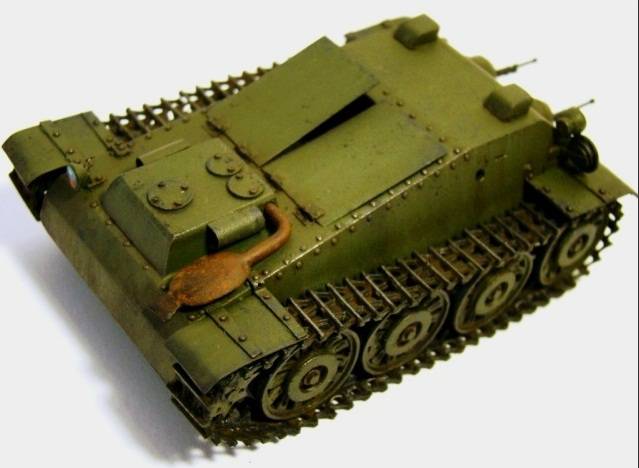
View of the stern. Photo Bronetechnikamira.ru
The military felt that the survivability of the “217 Object” in some situations may not be sufficient. 20-mm frontal armor could not protect the crew from the shells of tank and field guns, and the relatively low mobility made it difficult to escape from the shelling. Another reason for the claims was the deployment of the crew in a combat position, not very different comfort. The need to use a weapon in the supine position, as well as the absence of shock absorbers in the running gear, led to a rapid fatigue of the crew with a reduction in the efficiency of its work.
The last minus of the project, which influenced the final decision of the military, was too late its appearance. A new wedge was developed in connection with the participation of the Red Army in the Soviet-Finnish war. It could be used during this conflict and have a certain impact on the course of the battles. However, by the time the project was completed, the war was over. Because of this, the future development of the future was in question. It was required to conduct a comprehensive analysis of the test results and make a final decision.
With all its advantages, the wedge “Object 217” had a lot of shortcomings that could seriously hinder its operation, as well as limit the potential in terms of combat use. Because of this, new development was considered unpromising. The army command ordered to stop work on an unsuccessful project. At the same time there was a cancellation of the order for the construction of several new prototypes. On adoption and mass production of speech was no longer going.
During the work on the project “Object 217” / PPG-1, a complete set of design documentation was prepared and a single prototype was built. After the test was completed, the need to save the prototype wedge was gone. Exact information about the only prototype built is missing, but apparently, soon after the project was closed, it was disposed of as unnecessary. By the beginning of the forties, the development of armored vehicles led to a drastic reduction in the potential of tankettes and, as a result, to a gradual abandonment of such light combat vehicles. The project "Object 217" was the last national attempt to create tanketki. In the future, Soviet engineers were not engaged in this topic.
Based on:
http://alternathistory.com/
http://bronetechnikamira.ru/
http://otvaga2004.ru/
Solyankin A. G., Pavlov M. V., Pavlov I. V., Zheltov I. G. Domestic armored vehicles. XX century. - M .: Exprint, 2002. - T. 1. 1905 – 1941
Information